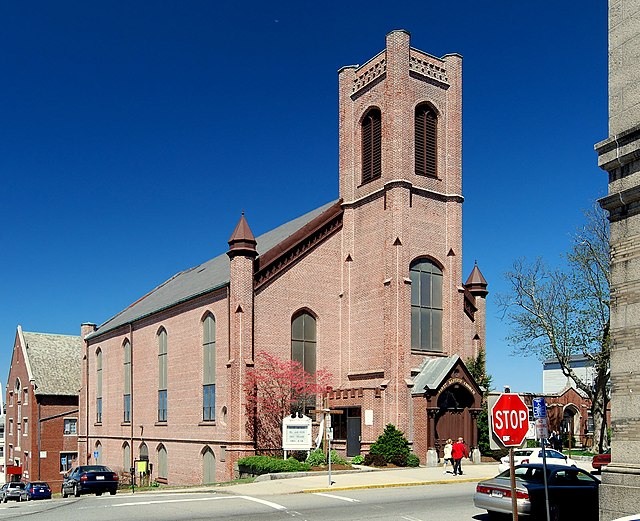Loading AI tools
American engineer From Wikipedia, the free encyclopedia
Josiah Brown (1816–1875) was an American architect and civil and mill engineer of Fall River, Massachusetts. Among his major surviving projects are the Union Mill No. 1 (1859) and Border City Mill No. 2 (1873), both in Fall River.
Josiah Brown | |
|---|---|
| Born | July 10, 1816 |
| Died | July 30, 1875 |
| Occupation | Architect |

Josiah Brown was born July 10, 1816, in Smithfield, Rhode Island, to Parley and Lucy (Southwick) Brown.[1] Parley Brown was a methodist minister and was later a resident of East Douglas.
Brown received some education from his father, but he was mostly self-taught. He was a resident of Fall River by 1847,[lower-alpha 1] and was noted as an "Architect" in the first Fall River directory of 1853. In some of his early mill projects, Brown was assisted by the prominent machinist and mill superintendent William C. Davol.[3] Brown was also the first employer of William C. Davol Jr.,[4] who would later establish the Davol Mills.[lower-alpha 2] From 1870 to 1875 William T. Henry, a graduate of the Massachusetts Institute of Technology, was in his office. Brown died July 30, 1875,[5] at which point Henry succeeded to his practice.[6]
The cause of death was Bright's disease.[7]
In addition to his architectural and mill engineering work, Brown was involved in the Hoosac Tunnel project, serving as Chief Assistant Engineer under Thomas Doane, Chief Engineer from 1863 to 1867.[8] He was also involved financially in several of his manufacturing projects. He was both organizer and initial president of the Montaup Mills, incorporated in 1871, and a director of the Robeson Mills, incorporated in 1866.[9] At the time of his death, he was also a director of the Davol Mills,[10] though it is not known if he was the architect.
He was the designer of several works listed on the United States National Register of Historic Places.[11][12]
| Year | Building | Address | City | State | Notes | Image | Reference |
|---|---|---|---|---|---|---|---|
| 1850 | First Baptist Church | 228 N Main St | Fall River | Massachusetts | Listed on the National Register of Historic Places in 1983.[11] |  | [13] |
| 1855 | Plan of Oak Grove Cemetery | 765 Prospect St | Fall River | Massachusetts | Designed on the model of Mount Auburn Cemetery, the archetypical garden cemetery. Listed on the National Register of Historic Places in 1983.[11] |  | [14] |
| 1857 | Plan of Evergreen Cemetery | 49 West St | East Douglas | Massachusetts | [15] | ||
| 1858 | House for Josiah Brown | 521 N Main St | Fall River | Massachusetts | The architect's own home. | [16] | |
| 1859 | Union Mill No. 1 | 289 Pleasant St | Fall River | Massachusetts | Listed on the National Register of Historic Places in 1983.[11] |  | [17][9] |
| 1866 | Robeson Mill No. 1 | 350 Rodman St | Fall River | Massachusetts | Demolished in 2001. |  | [9] |
| 1872 | Border City Mill No. 1 | 1 West St | Fall River | Massachusetts | Burned in 1877. | [9] | |
| 1872 | Montaup Mill | 1089 Dwelly St | Fall River | Massachusetts | Brown was the organizer and first president of the Montaup company. Later Osborn Mill No. 2. Burned in 1940. | [9] | |
| 1873 | Border City Mill No. 2 | 2 Weaver St | Fall River | Massachusetts | Listed on the National Register of Historic Places in 1990.[11] |  | [18] |
Seamless Wikipedia browsing. On steroids.
Every time you click a link to Wikipedia, Wiktionary or Wikiquote in your browser's search results, it will show the modern Wikiwand interface.
Wikiwand extension is a five stars, simple, with minimum permission required to keep your browsing private, safe and transparent.